Research Methodology: Data Analysis and Sampling Techniques Assignment
VerifiedAdded on 2022/08/22
|7
|1106
|28
Homework Assignment
AI Summary
This assignment delves into key aspects of research methodology within a business context. It begins by exploring the factors that contribute to the low utilization of secondary data in business research, considering issues such as data structure, accuracy, and accessibility. The assignment then provides a detailed rationale for selecting a specific sampling method in a research project, emphasizing the importance of aligning the method with the research goals and the nature of the population being studied. The discussion covers various sampling techniques, including probabilistic and non-probabilistic methods. Finally, the assignment examines the generalizability of research findings based on different sampling types. It highlights how probabilistic sampling methods are often preferred for their ability to provide a more accurate representation of the overall population, thereby enhancing the applicability of the research results. The assignment underscores the importance of methodological rigor in business research and the impact of sampling choices on the validity and utility of research outcomes.
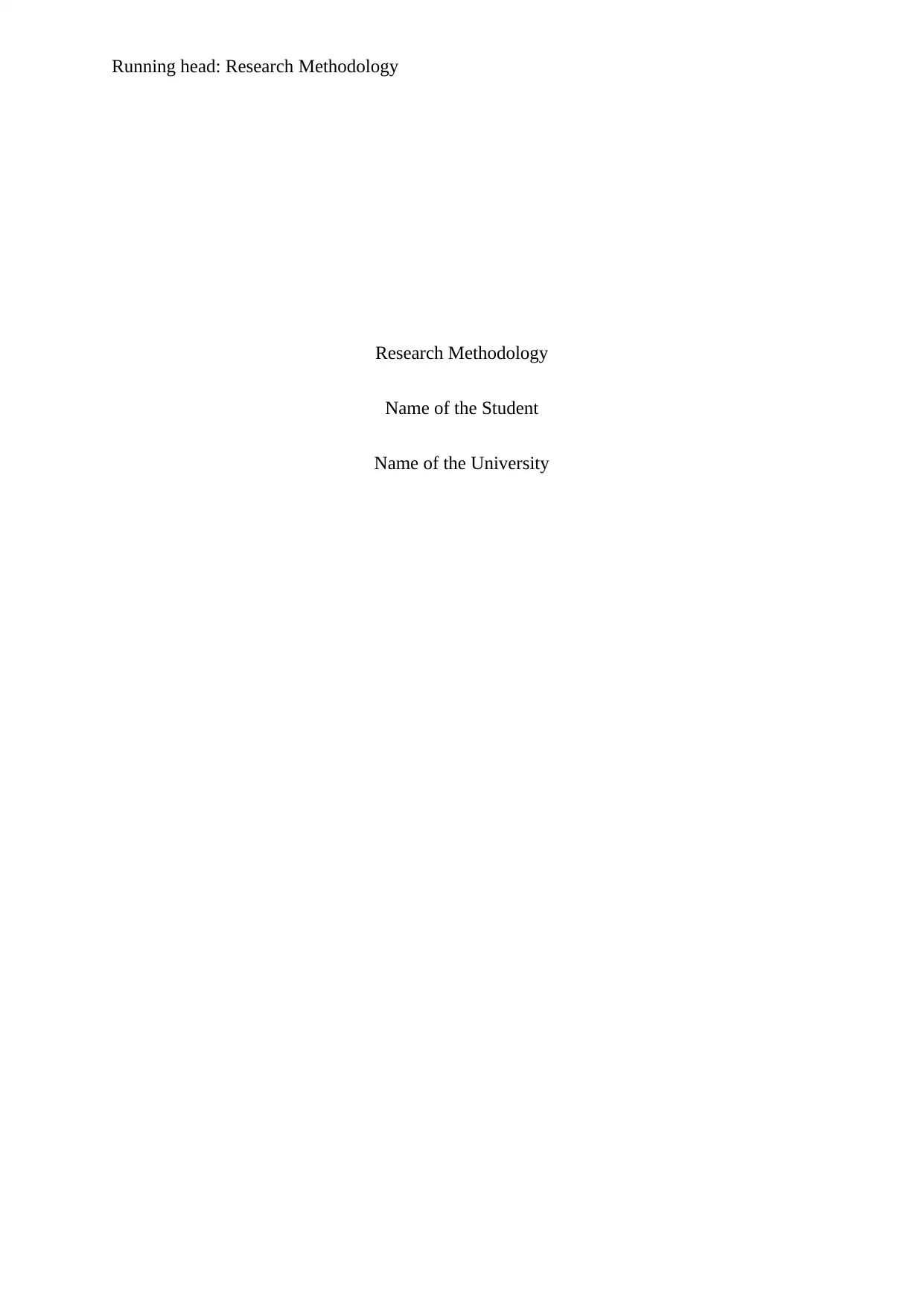
Running head: Research Methodology
Research Methodology
Name of the Student
Name of the University
Research Methodology
Name of the Student
Name of the University
Paraphrase This Document
Need a fresh take? Get an instant paraphrase of this document with our AI Paraphraser

2Research Methodology
Table of Contents
Q1...............................................................................................................................................3
Q2...............................................................................................................................................4
Q3...............................................................................................................................................5
References:.................................................................................................................................6
Table of Contents
Q1...............................................................................................................................................3
Q2...............................................................................................................................................4
Q3...............................................................................................................................................5
References:.................................................................................................................................6
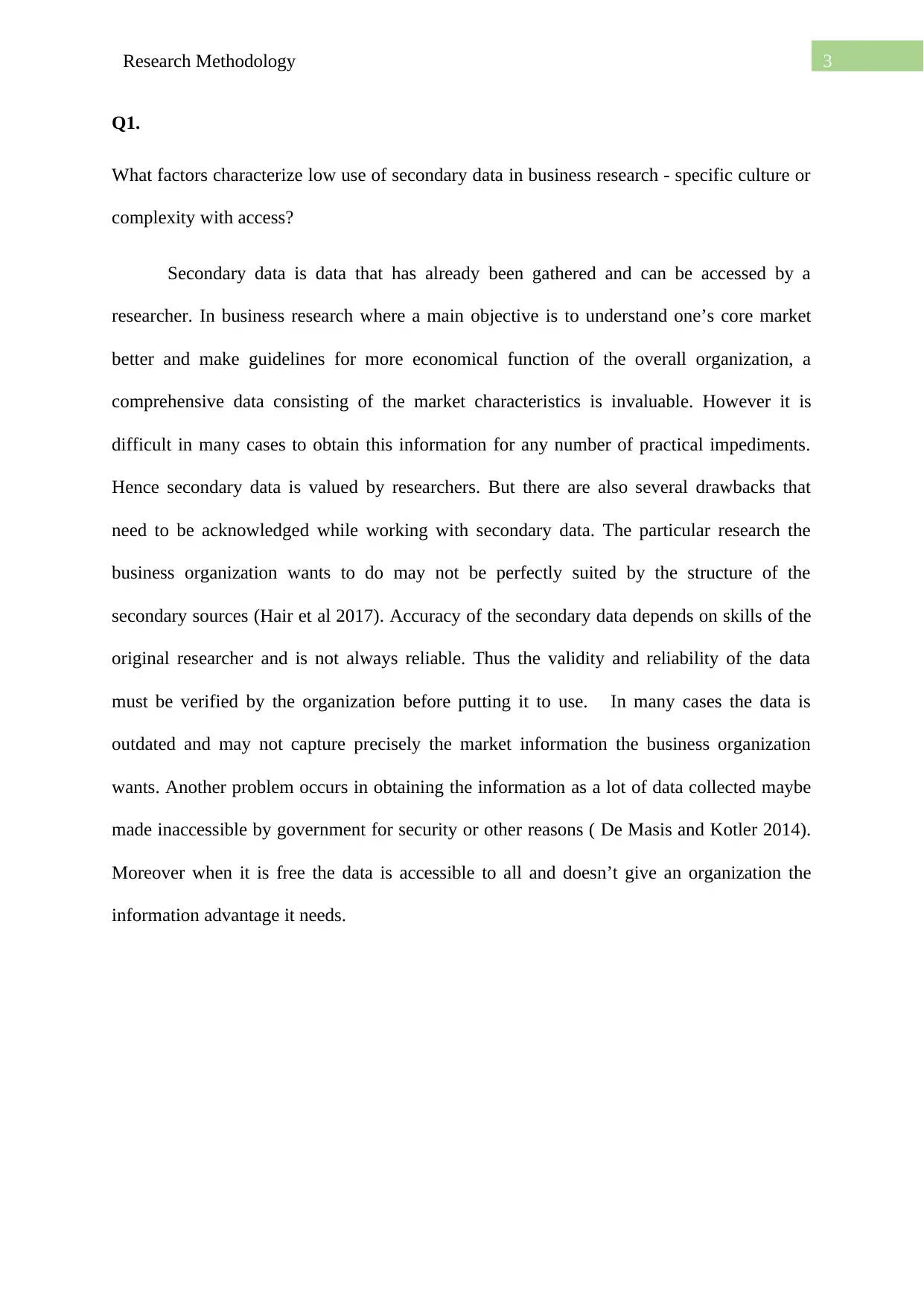
3Research Methodology
Q1.
What factors characterize low use of secondary data in business research - specific culture or
complexity with access?
Secondary data is data that has already been gathered and can be accessed by a
researcher. In business research where a main objective is to understand one’s core market
better and make guidelines for more economical function of the overall organization, a
comprehensive data consisting of the market characteristics is invaluable. However it is
difficult in many cases to obtain this information for any number of practical impediments.
Hence secondary data is valued by researchers. But there are also several drawbacks that
need to be acknowledged while working with secondary data. The particular research the
business organization wants to do may not be perfectly suited by the structure of the
secondary sources (Hair et al 2017). Accuracy of the secondary data depends on skills of the
original researcher and is not always reliable. Thus the validity and reliability of the data
must be verified by the organization before putting it to use. In many cases the data is
outdated and may not capture precisely the market information the business organization
wants. Another problem occurs in obtaining the information as a lot of data collected maybe
made inaccessible by government for security or other reasons ( De Masis and Kotler 2014).
Moreover when it is free the data is accessible to all and doesn’t give an organization the
information advantage it needs.
Q1.
What factors characterize low use of secondary data in business research - specific culture or
complexity with access?
Secondary data is data that has already been gathered and can be accessed by a
researcher. In business research where a main objective is to understand one’s core market
better and make guidelines for more economical function of the overall organization, a
comprehensive data consisting of the market characteristics is invaluable. However it is
difficult in many cases to obtain this information for any number of practical impediments.
Hence secondary data is valued by researchers. But there are also several drawbacks that
need to be acknowledged while working with secondary data. The particular research the
business organization wants to do may not be perfectly suited by the structure of the
secondary sources (Hair et al 2017). Accuracy of the secondary data depends on skills of the
original researcher and is not always reliable. Thus the validity and reliability of the data
must be verified by the organization before putting it to use. In many cases the data is
outdated and may not capture precisely the market information the business organization
wants. Another problem occurs in obtaining the information as a lot of data collected maybe
made inaccessible by government for security or other reasons ( De Masis and Kotler 2014).
Moreover when it is free the data is accessible to all and doesn’t give an organization the
information advantage it needs.
⊘ This is a preview!⊘
Do you want full access?
Subscribe today to unlock all pages.

Trusted by 1+ million students worldwide
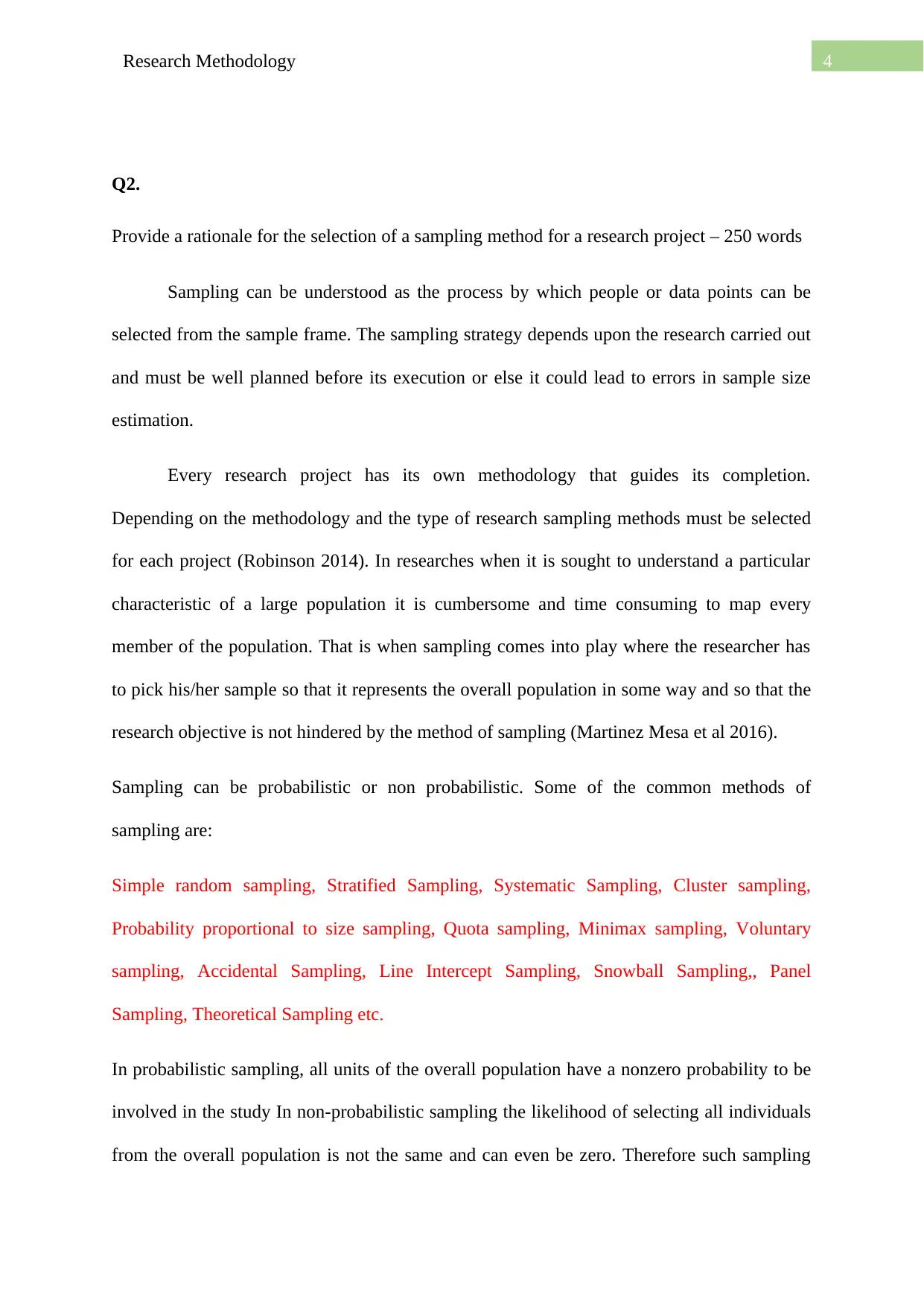
4Research Methodology
Q2.
Provide a rationale for the selection of a sampling method for a research project – 250 words
Sampling can be understood as the process by which people or data points can be
selected from the sample frame. The sampling strategy depends upon the research carried out
and must be well planned before its execution or else it could lead to errors in sample size
estimation.
Every research project has its own methodology that guides its completion.
Depending on the methodology and the type of research sampling methods must be selected
for each project (Robinson 2014). In researches when it is sought to understand a particular
characteristic of a large population it is cumbersome and time consuming to map every
member of the population. That is when sampling comes into play where the researcher has
to pick his/her sample so that it represents the overall population in some way and so that the
research objective is not hindered by the method of sampling (Martinez Mesa et al 2016).
Sampling can be probabilistic or non probabilistic. Some of the common methods of
sampling are:
Simple random sampling, Stratified Sampling, Systematic Sampling, Cluster sampling,
Probability proportional to size sampling, Quota sampling, Minimax sampling, Voluntary
sampling, Accidental Sampling, Line Intercept Sampling, Snowball Sampling,, Panel
Sampling, Theoretical Sampling etc.
In probabilistic sampling, all units of the overall population have a nonzero probability to be
involved in the study In non-probabilistic sampling the likelihood of selecting all individuals
from the overall population is not the same and can even be zero. Therefore such sampling
Q2.
Provide a rationale for the selection of a sampling method for a research project – 250 words
Sampling can be understood as the process by which people or data points can be
selected from the sample frame. The sampling strategy depends upon the research carried out
and must be well planned before its execution or else it could lead to errors in sample size
estimation.
Every research project has its own methodology that guides its completion.
Depending on the methodology and the type of research sampling methods must be selected
for each project (Robinson 2014). In researches when it is sought to understand a particular
characteristic of a large population it is cumbersome and time consuming to map every
member of the population. That is when sampling comes into play where the researcher has
to pick his/her sample so that it represents the overall population in some way and so that the
research objective is not hindered by the method of sampling (Martinez Mesa et al 2016).
Sampling can be probabilistic or non probabilistic. Some of the common methods of
sampling are:
Simple random sampling, Stratified Sampling, Systematic Sampling, Cluster sampling,
Probability proportional to size sampling, Quota sampling, Minimax sampling, Voluntary
sampling, Accidental Sampling, Line Intercept Sampling, Snowball Sampling,, Panel
Sampling, Theoretical Sampling etc.
In probabilistic sampling, all units of the overall population have a nonzero probability to be
involved in the study In non-probabilistic sampling the likelihood of selecting all individuals
from the overall population is not the same and can even be zero. Therefore such sampling
Paraphrase This Document
Need a fresh take? Get an instant paraphrase of this document with our AI Paraphraser
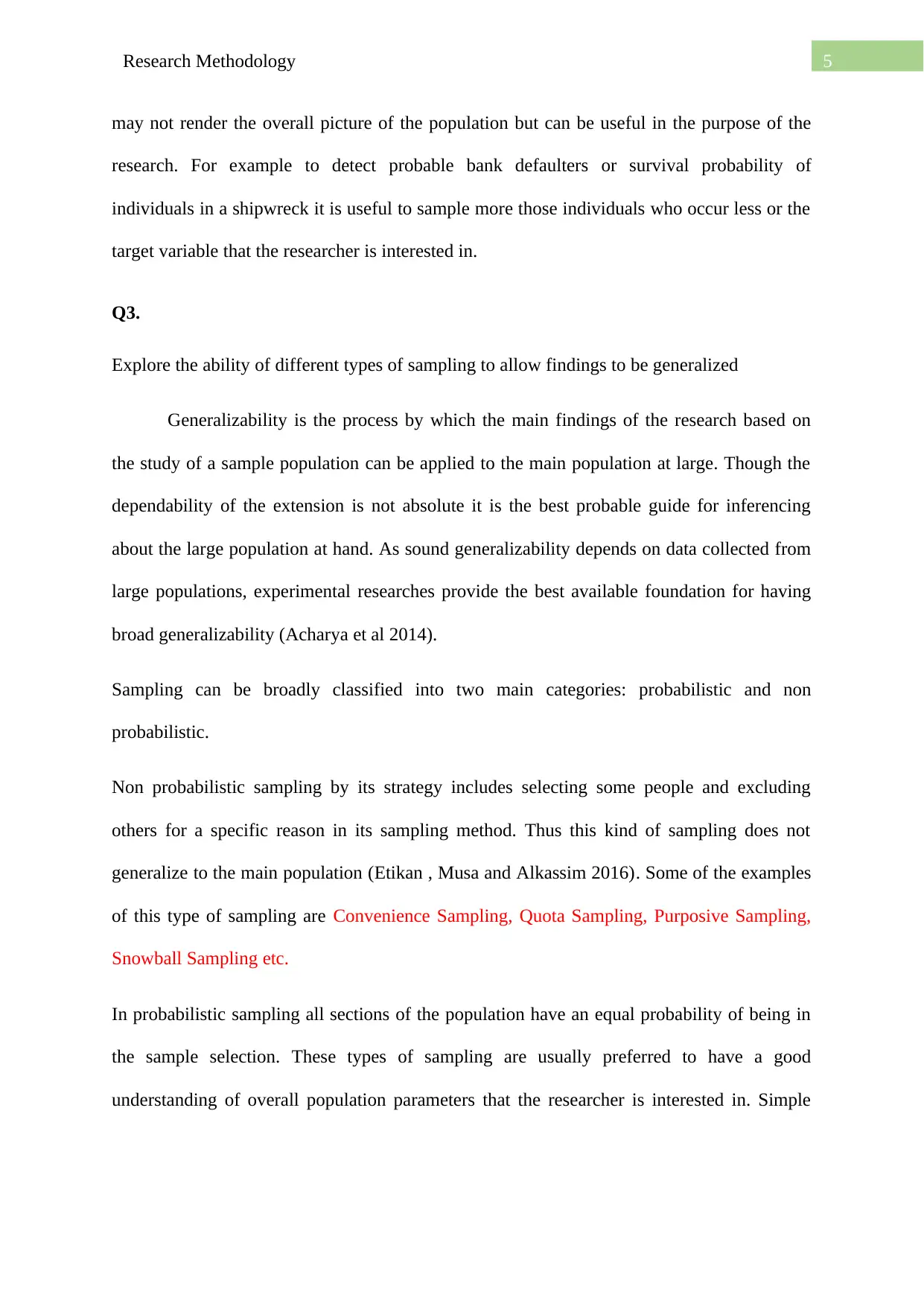
5Research Methodology
may not render the overall picture of the population but can be useful in the purpose of the
research. For example to detect probable bank defaulters or survival probability of
individuals in a shipwreck it is useful to sample more those individuals who occur less or the
target variable that the researcher is interested in.
Q3.
Explore the ability of different types of sampling to allow findings to be generalized
Generalizability is the process by which the main findings of the research based on
the study of a sample population can be applied to the main population at large. Though the
dependability of the extension is not absolute it is the best probable guide for inferencing
about the large population at hand. As sound generalizability depends on data collected from
large populations, experimental researches provide the best available foundation for having
broad generalizability (Acharya et al 2014).
Sampling can be broadly classified into two main categories: probabilistic and non
probabilistic.
Non probabilistic sampling by its strategy includes selecting some people and excluding
others for a specific reason in its sampling method. Thus this kind of sampling does not
generalize to the main population (Etikan , Musa and Alkassim 2016). Some of the examples
of this type of sampling are Convenience Sampling, Quota Sampling, Purposive Sampling,
Snowball Sampling etc.
In probabilistic sampling all sections of the population have an equal probability of being in
the sample selection. These types of sampling are usually preferred to have a good
understanding of overall population parameters that the researcher is interested in. Simple
may not render the overall picture of the population but can be useful in the purpose of the
research. For example to detect probable bank defaulters or survival probability of
individuals in a shipwreck it is useful to sample more those individuals who occur less or the
target variable that the researcher is interested in.
Q3.
Explore the ability of different types of sampling to allow findings to be generalized
Generalizability is the process by which the main findings of the research based on
the study of a sample population can be applied to the main population at large. Though the
dependability of the extension is not absolute it is the best probable guide for inferencing
about the large population at hand. As sound generalizability depends on data collected from
large populations, experimental researches provide the best available foundation for having
broad generalizability (Acharya et al 2014).
Sampling can be broadly classified into two main categories: probabilistic and non
probabilistic.
Non probabilistic sampling by its strategy includes selecting some people and excluding
others for a specific reason in its sampling method. Thus this kind of sampling does not
generalize to the main population (Etikan , Musa and Alkassim 2016). Some of the examples
of this type of sampling are Convenience Sampling, Quota Sampling, Purposive Sampling,
Snowball Sampling etc.
In probabilistic sampling all sections of the population have an equal probability of being in
the sample selection. These types of sampling are usually preferred to have a good
understanding of overall population parameters that the researcher is interested in. Simple
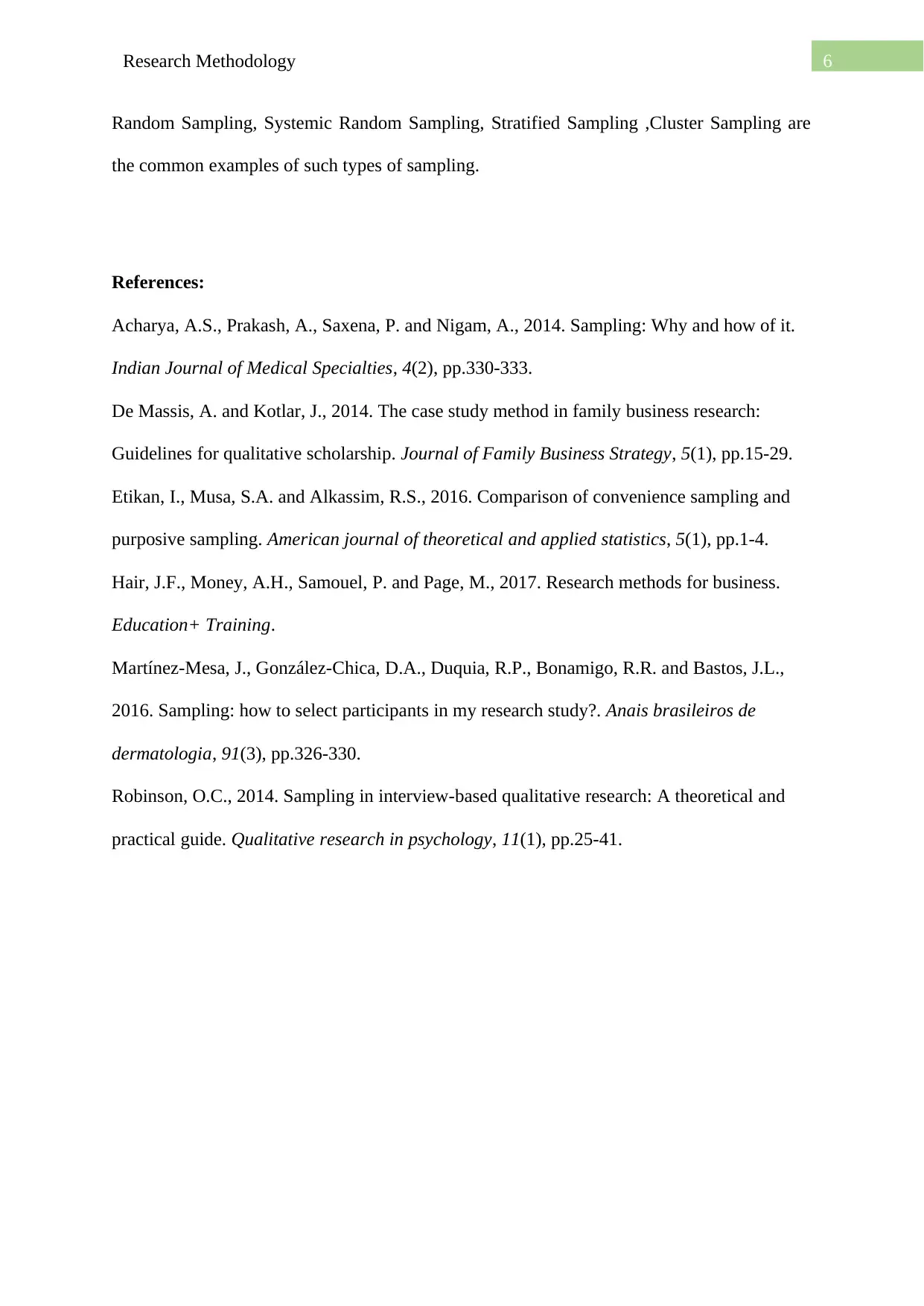
6Research Methodology
Random Sampling, Systemic Random Sampling, Stratified Sampling ,Cluster Sampling are
the common examples of such types of sampling.
References:
Acharya, A.S., Prakash, A., Saxena, P. and Nigam, A., 2014. Sampling: Why and how of it.
Indian Journal of Medical Specialties, 4(2), pp.330-333.
De Massis, A. and Kotlar, J., 2014. The case study method in family business research:
Guidelines for qualitative scholarship. Journal of Family Business Strategy, 5(1), pp.15-29.
Etikan, I., Musa, S.A. and Alkassim, R.S., 2016. Comparison of convenience sampling and
purposive sampling. American journal of theoretical and applied statistics, 5(1), pp.1-4.
Hair, J.F., Money, A.H., Samouel, P. and Page, M., 2017. Research methods for business.
Education+ Training.
Martínez-Mesa, J., González-Chica, D.A., Duquia, R.P., Bonamigo, R.R. and Bastos, J.L.,
2016. Sampling: how to select participants in my research study?. Anais brasileiros de
dermatologia, 91(3), pp.326-330.
Robinson, O.C., 2014. Sampling in interview-based qualitative research: A theoretical and
practical guide. Qualitative research in psychology, 11(1), pp.25-41.
Random Sampling, Systemic Random Sampling, Stratified Sampling ,Cluster Sampling are
the common examples of such types of sampling.
References:
Acharya, A.S., Prakash, A., Saxena, P. and Nigam, A., 2014. Sampling: Why and how of it.
Indian Journal of Medical Specialties, 4(2), pp.330-333.
De Massis, A. and Kotlar, J., 2014. The case study method in family business research:
Guidelines for qualitative scholarship. Journal of Family Business Strategy, 5(1), pp.15-29.
Etikan, I., Musa, S.A. and Alkassim, R.S., 2016. Comparison of convenience sampling and
purposive sampling. American journal of theoretical and applied statistics, 5(1), pp.1-4.
Hair, J.F., Money, A.H., Samouel, P. and Page, M., 2017. Research methods for business.
Education+ Training.
Martínez-Mesa, J., González-Chica, D.A., Duquia, R.P., Bonamigo, R.R. and Bastos, J.L.,
2016. Sampling: how to select participants in my research study?. Anais brasileiros de
dermatologia, 91(3), pp.326-330.
Robinson, O.C., 2014. Sampling in interview-based qualitative research: A theoretical and
practical guide. Qualitative research in psychology, 11(1), pp.25-41.
⊘ This is a preview!⊘
Do you want full access?
Subscribe today to unlock all pages.

Trusted by 1+ million students worldwide

7Research Methodology
1 out of 7
Related Documents
Your All-in-One AI-Powered Toolkit for Academic Success.
+13062052269
info@desklib.com
Available 24*7 on WhatsApp / Email
![[object Object]](/_next/static/media/star-bottom.7253800d.svg)
Unlock your academic potential
Copyright © 2020–2025 A2Z Services. All Rights Reserved. Developed and managed by ZUCOL.





